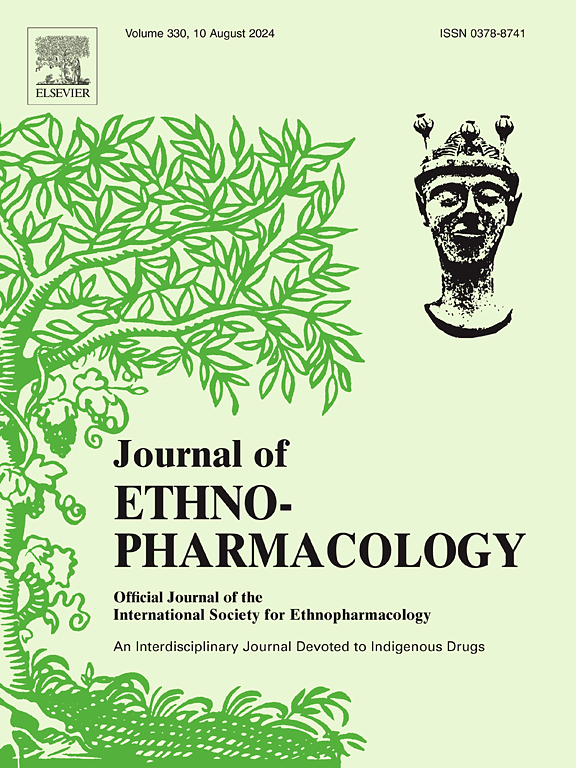Heshuxiaoji pill suppresses steatohepatitis and fibrosis by regulating the AngII-BACH1 mediated vasoconstriction
IF 4.8
2区 医学
Q1 CHEMISTRY, MEDICINAL
引用次数: 0
Abstract
Ethnopharmacological relevance
Non-alcoholic steatohepatitis (NASH), a widespread hepatic affliction marked by hepatic fibrosis progression towards hepatocellular carcinoma, is significantly influenced by endothelial dysfunction and endothelial-to-mesenchymal transition (EndMT). Although Heshuxiaoji (HSXJ) Pill, an empirical prescription formulated by Prof. Tongjiao Sun has demonstrated significant efficacy in mitigating steatohepatitis and fibrosis, the precise mechanisms underlying its therapeutic effects remain to be fully elucidated.
Aim of the study
To investigate the antifibrotic effect of HSXJ pill and to explore its mechanism in vivo and in vitro.
Materials and methods
To probe the antifibrotic impact of HSXJ pill and unravel its mechanisms, murine liver fibrosis and NASH models were induced in vivo via Western diet and CCl4 injection. In vitro, human umbilical vein endothelial cells were stimulated with AngII, followed by Western blot analysis. Additionally, liver biopsies from patients with mild-to-moderate fibrosis (S1–S2) were utilized to verify EndMT involvement in fibrosis.
Results
In the hepatocyte sections exhibiting human liver fibrosis, we observed a significant upregulation of AngII and the transcription factor BTB and CNC homology 1 (BACH1). Genetic ablation of AngII significantly ameliorates hepatic fibrosis and EndMT, while attenuating pathological angiogenesis via decreased BACH1 expression. In contrast, AngII overexpression exacerbates these conditions. In vivo, the HSXJ pill effectively alleviates hepatic fibrosis, reduces alanine aminotransferase (ALT) and aspartate aminotransferase (AST) levels, and suppresses BACH1 and AngII production, thereby inhibiting EndMT. In vitro, the pill mitigates EndMT-associated fibrosis by regulating BACH1 to inhibit AngII activation.
Conclusion
The study indicates that the HSXJ pill effectively diminishes hepatocyte injury markers and alleviates liver fibrosis, with optimal efficacy at medium/high doses. BACH1 serves as a key regulator of hepatic fibrosis via modulation of AngII expression.
合舒消积丸通过调节血管i - bach1介导的血管收缩抑制脂肪性肝炎和纤维化。
民族药理学相关性:非酒精性脂肪性肝炎(NASH)是一种广泛存在的肝脏疾病,以肝纤维化进展为肝细胞癌为标志,受内皮功能障碍和内皮-间质转化(EndMT)的显著影响。和舒消积丸是孙同教教授的经验方,对脂肪性肝炎和肝纤维化有明显的缓解作用,但其治疗作用的确切机制尚不清楚。目的:观察HSXJ丸的抗纤维化作用,探讨其体内外作用机制。材料与方法:为探讨HSXJ丸的抗纤维化作用及其机制,采用西餐和注射CCl4在体内诱导小鼠肝纤维化和NASH模型。体外用AngII刺激人脐静脉内皮细胞,进行Western blot分析。此外,对轻至中度纤维化(S1-S2)患者进行肝活检,证实EndMT参与纤维化。结果:在显示人肝纤维化的肝细胞切片中,我们观察到AngII和转录因子BTB和CNC同源物1 (BACH1)的显著上调。基因消融AngII可显著改善肝纤维化和EndMT,同时通过降低BACH1表达来减弱病理性血管生成。相反,AngII过表达会加剧这些情况。在体内,HSXJ丸有效缓解肝纤维化,降低丙氨酸转氨酶(ALT)和天冬氨酸转氨酶(AST)水平,抑制BACH1和AngII的产生,从而抑制EndMT。在体外,该药通过调节BACH1抑制AngII激活来减轻endmt相关纤维化。结论:本研究提示HSXJ丸能有效降低肝细胞损伤标志物,减轻肝纤维化,且中、高剂量效果最佳。BACH1通过调节AngII的表达而成为肝纤维化的关键调节因子。
本文章由计算机程序翻译,如有差异,请以英文原文为准。
求助全文
约1分钟内获得全文
求助全文
来源期刊

Journal of ethnopharmacology
医学-全科医学与补充医学
CiteScore
10.30
自引率
5.60%
发文量
967
审稿时长
77 days
期刊介绍:
The Journal of Ethnopharmacology is dedicated to the exchange of information and understandings about people''s use of plants, fungi, animals, microorganisms and minerals and their biological and pharmacological effects based on the principles established through international conventions. Early people confronted with illness and disease, discovered a wealth of useful therapeutic agents in the plant and animal kingdoms. The empirical knowledge of these medicinal substances and their toxic potential was passed on by oral tradition and sometimes recorded in herbals and other texts on materia medica. Many valuable drugs of today (e.g., atropine, ephedrine, tubocurarine, digoxin, reserpine) came into use through the study of indigenous remedies. Chemists continue to use plant-derived drugs (e.g., morphine, taxol, physostigmine, quinidine, emetine) as prototypes in their attempts to develop more effective and less toxic medicinals.
 求助内容:
求助内容: 应助结果提醒方式:
应助结果提醒方式:


